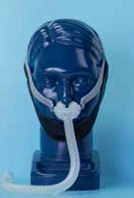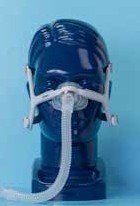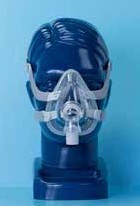Noninvasive Ventilator Use for Neuromuscular Weakness: A Guide to Noninvasive Ventilator (NIV)
This information was reviewed and approved by Amen Sergew, MD (8/1/2019).
This guide will help you address the most common challenges associated with noninvasive ventilator (NIV) therapy and improve comfort with your treatment.
How Does NIV Therapy Benefit Me?
Noninvasive ventilator (NIV) therapy (also called positive airway pressure or PAP) provides pressurized air through a mask to help push air into your lungs and help you breathe. By doing so, it improves your oxygen levels at night and thus improves your sleep quality. It has also been proven to improve quality of life and prolong life in people with neuromuscular weakness. PAP is also used for obstructive sleep apnea. This information relates to neuromuscular weakness and the use of NIV.
Symptoms Associated with Poor Sleep Include:
Daytime sleepiness and drowsy driving
Irritability
Depression/anxiety
Memory/concentration issues
Morning headaches
Using your NIV device as prescribed can improve sleep quality, reduce fatigue, enhance mental focus and decrease your risk of heart-related conditions.
Most Common NIV Devices
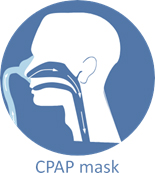 BiPAP
BiPAP
Bi-level positive airway pressure provides a higher pressure when you inhale and a lower pressure when you exhale.
AVAPS
AVAPS provides a higher pressure when you inhale and a lower pressure when you exhale and also guarantees a set amount of air to enter with each breath. This is used later on in your disease.
What Should I Expect When Starting NIV Therapy?
It will take some time to adjust to sleeping with NIV therapy.
Most people adjust over the course of a few weeks to a few months. It is important to understand that this is a lifestyle change and that becoming accustomed to NIV therapy is as much a mental shift as it is a physical adjustment. Reminding yourself why treatment is so important can help motivate you to be compliant with therapy. There also are many tips and tricks included in this guide to help with the most common issues you may face when starting NIV therapy.
Masks
There are three main types of masks available.
Nasal pillows/pieces: Sit underneath or just outside the openings of the nose. This is the lightest, least invasive mask, and it is a good option if you have issues with claustrophobia. This mask may leak more at higher pressures, and the headgear is not as adjustable. You may need a chin strap with this mask if you open your mouth when sleeping.
Nasal mask: Covers the nose and typically uses a four-point headgear. This is a good option if it is difficult for you to tolerate a mask over your nose and mouth. This mask can be difficult to tolerate if you experience significant nasal congestion. You may need a chin strap if you open your mouth when sleeping.
Full-face mask: Covers both your nose and mouth. This mask works well if you open your mouth when sleeping or have significant issues with nasal congestion. If the pressure feels too high with a nasal mask or nasal pillows, then a full-face mask can help disperse the pressure and improve comfort. It may be difficult to tolerate a full-face mask if you have issues with claustrophobia.
Nasal Pillow Mask |
Nasal Mask |
Full-face Mask |
Mask Fit
Finding the right mask can take time. Everyone has unique facial characteristics. Nose/chin sizes, face shape and facial hair are important considerations when choosing a mask. Your mask should be comfortable and not too tight on your face. Some minor leaking through the night when changing positions is normal, but excessive leaking that wakes you up should be addressed. Remember, if you are losing air pressure due to a poor mask seal, you are not getting the air pressure you need to keep your airway open. Insufficient pressure can cause your airway to collapse.
Dealing with Mask Leak
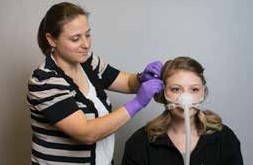 Make sure your mask cushion and headgear are the correct size.
Make sure your mask cushion and headgear are the correct size.If you have facial hair, consider shaving your face more often to reduce gaps between your skin and the mask, or try PAP beard gel to help improve the seal.
Ensure your mask is properly placed on your face.
Purchase or make your own cloth mask liners.
If you are a side sleeper, consider using a NIV pillow to prevent the mask from shifting out of place.
Some NIV machines have a “mask fit” feature you can use to check for leaks and ensure a good seal.
If you are still having mask issues, consider a mask-fitting session with your medical equipment provider or the Sleep Center at National Jewish Health.
Skin Sensitivities
Mask liners and headgear strap covers can be helpful in reducing skin irritation and marks on your face. These can be purchased online or through your medical equipment provider. Some people make their own liners with soft cloth or fabric.
Device Pressure
The air pressure setting on your machine has been prescribed for you based on your height and ideal body weight (much like selecting the dosing of a medication). You cannot make changes to your prescribed pressure setting; this requires a prescription from your medical provider.
If the air pressure is too forceful or too soft, contact your physician or durable medical equipment (DME) company. Depending on your machine, it may be possible to make changes via a wireless connection. A full-face mask may also help disperse the pressure and improve comfort.
Aerophagia: This occurs when you swallow air, which goes into your stomach and causes symptoms of bloating, abdominal discomfort and burping. Using pressure-relief settings can help. If this does not improve symptoms, speak to your medical provider.
Finally, your NIV pressure needs may change over time. Weight changes and increased weakness can affect how much air pressure you need. Bring your machine and mask to every appointment for evaluation by your physician and respiratory therapy.
Dryness
Dryness can be a major issue in the arid climate of Colorado. Nasal dryness can cause more nasal congestion, making NIV therapy harder to use. Adjusting your humidity settings and tube temperature (if applicable) on your NIV machine will help improve dryness. Using heated tubing will help increase your overall humidity and reduce moisture buildup inside the tube.
You also can try using a secondary room humidifier to increase the moisture in your room. Make sure that you clean the humidifier on a regular basis, and use distilled water.
There are several over-the-counter nasal sprays and gels to help with nasal dryness. Saline-based products are safe to use. Avoid petroleum-based products, such as Vaseline or antibiotic ointment, in your nose. There are also over-the-counter mouth sprays, toothpastes and mouthwashes available to improve mouth dryness.
A dry mouth in the morning is often a sign of mouth breathing, especially if you are not experiencing nasal dryness as well. If you breathe through your mouth when using a nasal mask/nasal pillows, you are losing air pressure every time you open your mouth, and may not be completely treating your apnea. Consider switching to a full-face mask or using a chin strap.
Nasal/Sinus Congestion
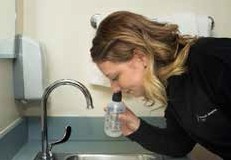 Nasal and sinus congestion can be a big hindrance to using NIV therapy. If you have nasal congestion, you may find it very challenging to tolerate nasal pillows or a nasal mask. Try increasing the humidity level on your NIV machine. Nasal saline rinses also are an inexpensive and effective remedy for sinus congestion. If you have ongoing congestion, ask your medical provider for recommendations.
Nasal and sinus congestion can be a big hindrance to using NIV therapy. If you have nasal congestion, you may find it very challenging to tolerate nasal pillows or a nasal mask. Try increasing the humidity level on your NIV machine. Nasal saline rinses also are an inexpensive and effective remedy for sinus congestion. If you have ongoing congestion, ask your medical provider for recommendations.
Water in the Hose
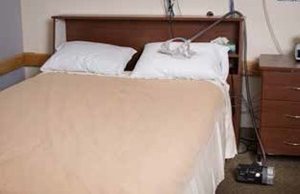 As the warmed and humidified air travels through your hose, it can cool off, causing condensation and leading to water dripping onto your face. Ask your provider about getting a heated hose and adjusting the temperature to prevent water buildup. If you cannot attach a heated hose to your NIV device, using a hose cover can help keep your humidified air from cooling off. Hose covers are available online, or you can make your own. Lowering the humidity level on your NIV device can help as well. You also can set your NIV machine on the floor to allow the water in your hose to drain back toward the machine instead of into your mask.
As the warmed and humidified air travels through your hose, it can cool off, causing condensation and leading to water dripping onto your face. Ask your provider about getting a heated hose and adjusting the temperature to prevent water buildup. If you cannot attach a heated hose to your NIV device, using a hose cover can help keep your humidified air from cooling off. Hose covers are available online, or you can make your own. Lowering the humidity level on your NIV device can help as well. You also can set your NIV machine on the floor to allow the water in your hose to drain back toward the machine instead of into your mask.
Obtrusive Tubing
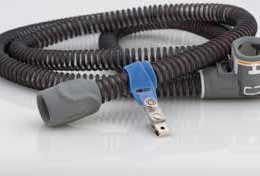 Hose stands help keep the hose out of your way and are available through various online sources. Some hose stands are collapsible for easy travel. A free and easy trick to keep your hose out of the way is to hang it over your headboard. Hose clips — Velcro straps that wrap around the tube and attach to your sheets or blankets with a metal clip — are another good option to keep the tube out of your face or from pulling when you change positions in bed.
Hose stands help keep the hose out of your way and are available through various online sources. Some hose stands are collapsible for easy travel. A free and easy trick to keep your hose out of the way is to hang it over your headboard. Hose clips — Velcro straps that wrap around the tube and attach to your sheets or blankets with a metal clip — are another good option to keep the tube out of your face or from pulling when you change positions in bed.
Claustrophobia and Anxiety
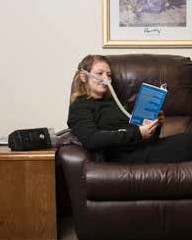 Feelings of claustrophobia and anxiety are a normal reaction to using NIV therapy. Remember, it takes time for most people to become accustomed to NIV therapy. The best way to get used to NIV therapy is to “practice” with the device. Using your NIV machine while you are awake and engaging in relaxing activities (reading, watching TV, meditating, etc.) can improve your comfort with the air pressure.
Feelings of claustrophobia and anxiety are a normal reaction to using NIV therapy. Remember, it takes time for most people to become accustomed to NIV therapy. The best way to get used to NIV therapy is to “practice” with the device. Using your NIV machine while you are awake and engaging in relaxing activities (reading, watching TV, meditating, etc.) can improve your comfort with the air pressure.
Trying a low-profile mask, such as a nasal mask or nasal pillows, can feel less intrusive and easier to tolerate. If you breathe through your mouth, you may consider using a chin strap with a nasal mask (instead of a larger full-face mask).
Taking Care of the NIV Device and Equipment
Cleaning and replacing your equipment on a regular basis helps prolong the life of your device and mask, as well as prevent upper respiratory infections. It is generally recommended that you clean and inspect your equipment once a week. If you are prone to nasal, sinus or lung infections, it is recommended that you clean your equipment more often.
Cleaning the Equipment
Use a mild dish soap to clean your hose, mask and humidifier chamber every week. To disinfect your supplies, use one part white vinegar to three parts water, soak for 20 minutes, then rinse well. Do not use harsh chemicals such as bleach, alcohol or ammonia on your equipment, as these are harmful to you and your equipment. Let your mask air dry on a clean towel and hang your hose over your shower curtain to dry. If there is still moisture in your hose, you can hook it up to your device (without humidity) and run air through the hose to dry it out.
NIV mask wipes are available for quick cleaning of your mask. Wiping down your mask each night can help eliminate oil residue and improve the seal.
Filters
Your filter will need to be changed regularly to avoid breathing in debris from your environment. A dirty or clogged filter also can wear out the motor in your NIV machine and may affect the performance of your machine. NIV machines can have a reusable filter, a disposable filter or both. Disposable filters should be changed at least once a month, or more often if they appear dirty. Reusable filters can be hand-washed once a week and replaced every six months to a year. It is recommended that you clean or replace your filters more often if you live in a dustier environment and/or have pets or smokers in your home.
Traveling with NIV
It is important to take your NIV machine with you when you travel, so make sure to plan ahead!
Plan to take your NIV machine with you as a carry-on item when flying. You may need a note or prescription from your medical provider. NIV machines will need to go through X-ray and may need to be taken out of the case.
Purchase distilled water for your humidifier chamber. You can use bottled water for short trips.
There are battery packs, converters and adapters available for purchase online if you are traveling overseas or will be without a power source.
There also are smaller travel devices available if you travel frequently, but these are not typically covered by insurance.
Meeting Insurance Compliance Requirements
Most insurance providers require you to meet usage requirements in order to be reimbursed for your equipment.
For Medicare and Medicaid, you have a 90-day trial period after receiving your NIV device. Within the first 90 days, you must use your device a minimum of four hours per night at least 70 percent of the time in a 30-day period (at least 21 out of 30 days). “Practicing” with your NIV device while you are awake counts toward your overall usage. These usage requirements may change.
Check with your medical equipment provider about specific usage requirements for your insurance plan. Remember, NIV therapy only works if you use it. Insurance usage requirements are minimal; to improve your health, you should aim for using NIV therapy anytime you are sleeping, including naps.
How Is My NIV Usage Determined?
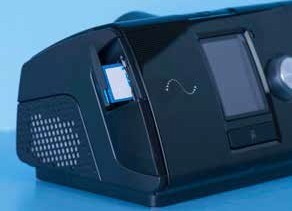 Most NIV machines have memory cards. Your medical provider or your medical equipment company can download your usage information from the memory card using special computer software programs.
Most NIV machines have memory cards. Your medical provider or your medical equipment company can download your usage information from the memory card using special computer software programs.
Newer NIV machines have a modem which will transmit usage data every 24 hours via Wi-Fi to a secure website that can only be accessed by your medical equipment company and medical provider. The data collected includes your usage, whether your lung volumes are sufficient and if your device is detecting excessive mask leak. Your physician will use this information to help manage your care
 Clinical Trials
Clinical Trials
For more than 100 years, National Jewish Health has been committed to finding new treatments and cures for diseases. Search our clinical trials.

